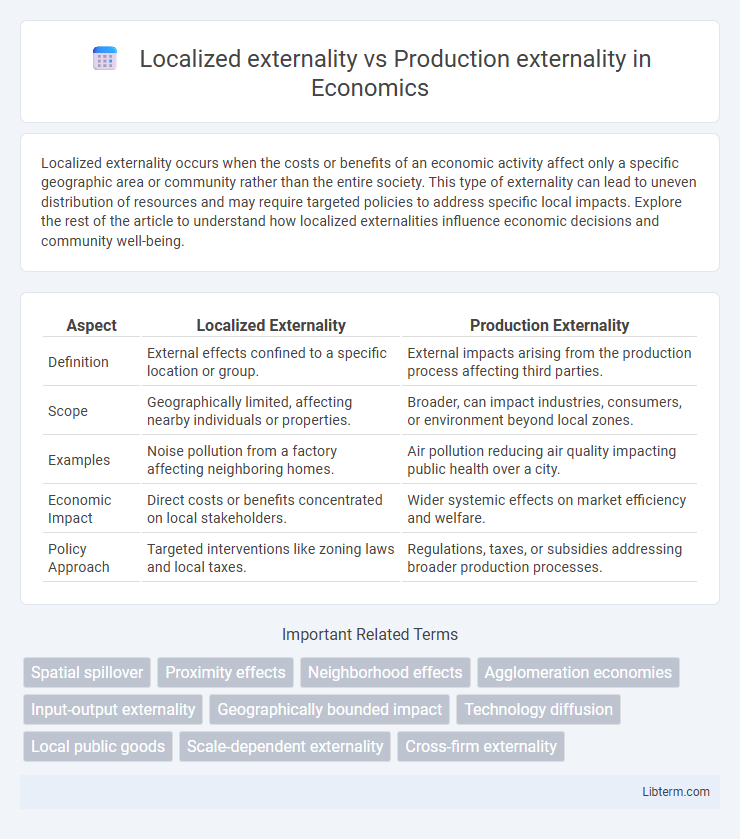Localized externality occurs when the costs or benefits of an economic activity affect only a specific geographic area or community rather than the entire society. This type of externality can lead to uneven distribution of resources and may require targeted policies to address specific local impacts. Explore the rest of the article to understand how localized externalities influence economic decisions and community well-being.
Table of Comparison
| Aspect | Localized Externality | Production Externality |
|---|---|---|
| Definition | External effects confined to a specific location or group. | External impacts arising from the production process affecting third parties. |
| Scope | Geographically limited, affecting nearby individuals or properties. | Broader, can impact industries, consumers, or environment beyond local zones. |
| Examples | Noise pollution from a factory affecting neighboring homes. | Air pollution reducing air quality impacting public health over a city. |
| Economic Impact | Direct costs or benefits concentrated on local stakeholders. | Wider systemic effects on market efficiency and welfare. |
| Policy Approach | Targeted interventions like zoning laws and local taxes. | Regulations, taxes, or subsidies addressing broader production processes. |
Understanding Externalities: A Brief Overview
Localized externalities occur when the effects of an economic activity impact a specific, limited geographic area, such as noise pollution affecting neighborhood residents near a construction site. Production externalities arise during the manufacturing process, where the production of goods generates unintended costs or benefits, like factory emissions contributing to air pollution. Understanding these distinctions is crucial for designing effective policies that target the source and affected parties of external costs or benefits.
What Are Localized Externalities?
Localized externalities occur when the effects of a production or consumption activity impact a specific geographic area or community, causing costs or benefits confined to that location. Unlike broad production externalities, which may influence prices or resources at a larger scale, localized externalities lead to issues like pollution, noise, or congestion that directly affect nearby residents or businesses. Understanding the spatial boundaries of these externalities is crucial for targeted policy interventions and efficient resource management.
Defining Production Externalities
Production externalities occur when the production activities of one firm impact other firms or individuals without compensation, often resulting in costs or benefits not reflected in market prices. These externalities can be negative, such as pollution emitted by a factory affecting neighboring businesses, or positive, like a beekeeper's bees pollinating nearby crops. Localized externalities specifically refer to those effects concentrated within a limited geographical area, amplifying the direct influence on adjacent firms or communities.
Key Differences Between Localized and Production Externalities
Localized externalities primarily affect a specific geographic area or community, causing impacts such as noise, pollution, or congestion that are limited in spatial scope. Production externalities arise from the process of producing goods or services, impacting costs and benefits not reflected in market prices, often influencing broader economic or environmental outcomes. The key difference lies in the spatial extent and source: localized externalities are site-specific and directly tied to consumption or local activities, while production externalities stem from production processes and can have widespread or diffuse effects beyond the immediate location.
Real-World Examples of Localized Externalities
Localized externalities occur when the negative or positive effects of a production or consumption activity are confined to a specific geographic area or community. An example includes industrial pollution from a factory contaminating a nearby river, impacting local residents' health and property values. Production externalities, by contrast, often involve broader effects like carbon emissions contributing to global climate change, which are not limited to the vicinity of the production site.
Production Externality Case Studies
Production externalities occur when the actions of a firm in the production process impose costs or benefits on unrelated third parties, often leading to market inefficiencies. Case studies such as the pollution emitted by factories in the textile industry demonstrate how negative production externalities can degrade air and water quality, causing health issues for nearby communities. Conversely, positive production externalities are observed in technological spillovers within the semiconductor industry, where innovations by one firm enhance productivity across the sector.
Economic Impacts of Localized vs. Production Externalities
Localized externalities, such as noise pollution or traffic congestion, impose direct costs on nearby residents and businesses, leading to decreased property values and reduced local productivity. Production externalities, including factory emissions or resource depletion, affect broader regions and industries, causing systemic inefficiencies and long-term economic degradation. Addressing these externalities requires targeted policies to internalize costs, improve resource allocation, and enhance overall economic welfare.
Policy Approaches: Addressing Localized and Production Externalities
Policy approaches to localized externalities often involve targeted regulations such as zoning laws, emission limits, or localized taxes that directly address the immediate impact on specific communities. Production externalities require broader policies like Pigouvian taxes, cap-and-trade systems, or subsidies incentivizing cleaner production processes to internalize external costs across entire industries. Effective management hinges on precise identification of externality sources and tailored interventions that balance economic activity with environmental and social welfare.
Challenges in Measuring Externalities
Localized externalities present challenges in measurement due to their spatially confined impacts, requiring granular data on affected areas and populations, which can be costly and complex to obtain. Production externalities complicate measurement further by involving multiple stages of production processes and diverse sectors, making it difficult to isolate specific external costs or benefits. Both types of externalities demand robust econometric models and interdisciplinary approaches to accurately quantify social costs and inform effective policy interventions.
Future Trends in Managing Externalities
Future trends in managing localized externalities emphasize precision regulation through advanced sensor technologies and geospatial data to address specific community impacts effectively. In contrast, production externalities management is shifting towards integrating circular economy principles and clean production methods to minimize negative spillovers at the source. Both approaches increasingly rely on digital platforms and AI-driven analytics to optimize interventions and enhance sustainability outcomes.
Localized externality Infographic

 libterm.com
libterm.com